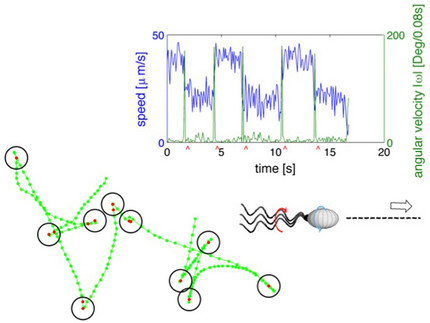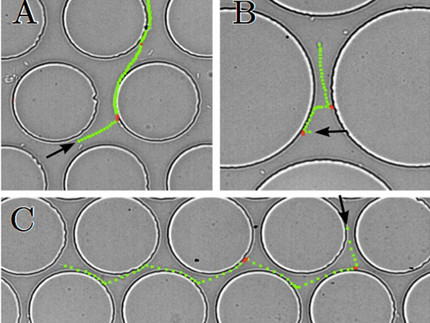Bacterial motility
Random walk of a polarly flagellated swimmer
Among the fundamental modes of motility in biological systems, bacterial swimming is one of the most widespread examples. It plays a central role in processes as diverse as intestinal functions, the spreading of infections, or the early stages of biofilm formation. Swimming bacteria propel themselves with the help of helical flagella that are driven by a rotary motor embedded in the cell wall. Our research concentrates on the soil bacterium Pseudomonas putida, a polarly flagellated swimmer that has attracted much attention because of its ability to degrade organic substances and detoxify polluted environments. Its swimming trajectories are dominated by sharp reversals and show a characteristic switching between two alternating speeds of propagation, resulting in a strongly enhanced mean square displacement.
- Carsten Beta, New J. Phys. 18 051003 (2016).
- M. Theves, J. Taktikos, V. Zaburdaev, H. Stark, and C. Beta, Biophys. J. 105 (8), 1915-1924 (2013).
Confinement and complex environments
The natural habitat of many bacterial swimmers is dominated by interfaces and narrow interstitial spacings where they frequently interact with the fluid boundaries in their vicinity. To characterize the impact of wall effects and the interplay between swimming pattern and environmental geometry, we investigated swimming of the soil bacterium Pseudomonas putida in a variety of confined micro-environments. PDMS-based soft lithography allows us to readily fabricate structured microchannels of different geometry and dimension, where confinement effects and related changes in the swimming pattern can be systematically studies.
- M. Raatz, M. Hintsche, M. Bahrs, M. Theves, and C. Beta, Eur. Phys. J. ST 224, 1185-1198 (2015).
- M. Theves, J. Taktikos, V. Zaburdaev, H. Stark, and C. Beta, EPL 109, 28007 (2015).


